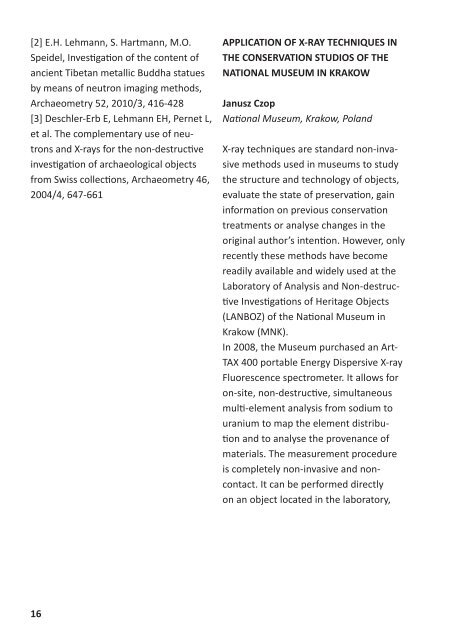4th Meeting X-ray techniques in investigations of the ... - CrysAC
4th Meeting X-ray techniques in investigations of the ... - CrysAC
4th Meeting X-ray techniques in investigations of the ... - CrysAC
You also want an ePaper? Increase the reach of your titles
YUMPU automatically turns print PDFs into web optimized ePapers that Google loves.
[2] E.H. Lehmann, S. Hartmann, M.O.<br />
Speidel, Investigation <strong>of</strong> <strong>the</strong> content <strong>of</strong><br />
ancient Tibetan metallic Buddha statues<br />
by means <strong>of</strong> neutron imag<strong>in</strong>g methods,<br />
Archaeometry 52, 2010/3, 416-428<br />
[3] Deschler-Erb E, Lehmann EH, Pernet L,<br />
et al. The complementary use <strong>of</strong> neutrons<br />
and X-<strong>ray</strong>s for <strong>the</strong> non-destructive<br />
<strong>in</strong>vestigation <strong>of</strong> archaeological objects<br />
from Swiss collections, Archaeometry 46,<br />
2004/4, 647-661<br />
16<br />
APPLICATION OF X-RAY TECHNIQUES IN<br />
THE CONSERVATION STUDIOS OF THE<br />
NATIONAL MUSEUM IN KRAKOW<br />
Janusz Czop<br />
�ational �useum� Krakow� Poland<br />
X-<strong>ray</strong> <strong>techniques</strong> are standard non-<strong>in</strong>vasive<br />
methods used <strong>in</strong> museums to study<br />
<strong>the</strong> structure and technology <strong>of</strong> objects,<br />
evaluate <strong>the</strong> state <strong>of</strong> preservation, ga<strong>in</strong><br />
<strong>in</strong>formation on previous conservation<br />
treatments or analyse changes <strong>in</strong> <strong>the</strong><br />
orig<strong>in</strong>al author’s <strong>in</strong>tention. However, only<br />
recently <strong>the</strong>se methods have become<br />
readily available and widely used at <strong>the</strong><br />
Laboratory <strong>of</strong> Analysis and Non-destructive<br />
Investigations <strong>of</strong> Heritage Objects<br />
(LANBOZ) <strong>of</strong> <strong>the</strong> National Museum <strong>in</strong><br />
Krakow (MNK).<br />
In 2008, <strong>the</strong> Museum purchased an Art-<br />
TAX 400 portable Energy Dispersive X-<strong>ray</strong><br />
Fluorescence spectrometer. It allows for<br />
on-site, non-destructive, simultaneous<br />
multi-element analysis from sodium to<br />
uranium to map <strong>the</strong> element distribution<br />
and to analyse <strong>the</strong> provenance <strong>of</strong><br />
materials. The measurement procedure<br />
is completely non-<strong>in</strong>vasive and noncontact.<br />
It can be performed directly<br />
on an object located <strong>in</strong> <strong>the</strong> laboratory,


